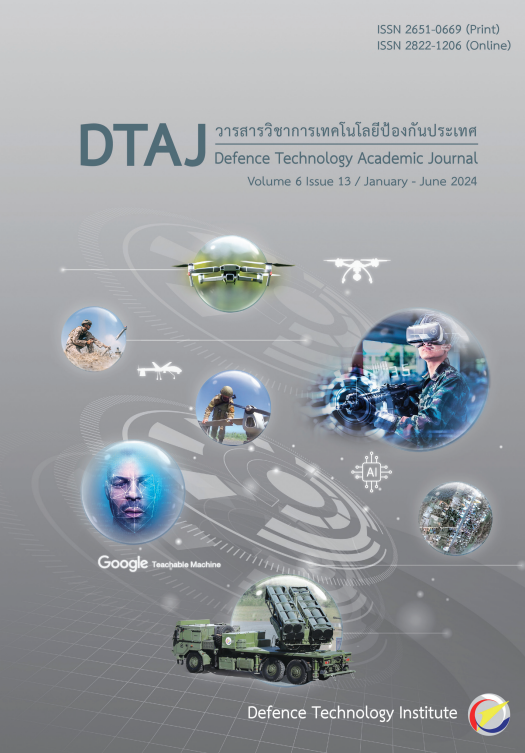Comparison between Equilibrium Optimization and Systune on Aircraft Blank Angle Control
Main Article Content
Abstract
This paper is a direct comparison of equilibrium optimization (EO) one of the classes of meta-heuristic (MH) known for nonlinear optimization capability and Systune designed specifically for control problems for aircraft blank angle control. The control structure consisted of aileron rudder interconnection, Dutch roll damping, and proportional and integral (PI) control gain. These are set as design variables with multiple objectives and constraints including performance and robustness. The model parameter is allowed to vary up to 10% of the nominal value. The worst-case gain result was then used to evaluate the performance of the controller obtained by each approach. Overall, the EO result is superior in terms of Dutch roll damping and robustness while other aspects especially in time domain requirement is only slightly better than the result acquired from Systune.
Downloads
Article Details

This work is licensed under a Creative Commons Attribution-NonCommercial-NoDerivatives 4.0 International License.
Journal of TCI is licensed under a Creative Commons Attribution-NonCommercial-NoDerivatives 4.0 International (CC BY-NC-ND 4.0) licence, unless otherwise stated. Please read our Policies page for more information...
References
J. D. Barton, “Fundamentals of Small Unmanned Aircraft Flight,” Johns Hopkins APL Tech. Dig., vol. 31, no. 2, pp. 132–149, 2012,
M. Jayalakshmi, V. V. Patel, and G. K. Singh, “Relook at Aileron to Rudder Interconnect,” Def. Sci. J., vol. 71, no. 2, pp. 153-161, 2021, doi: 10.14429/dsj.71.15347.
W. P. Gilbert, L. T. Nguyen, and R. W. Vangunst, “Simulator Study of the Effectiveness of an Automatic Control System Designed to Improve the High Angle of Attack Characteristics of a Fighter Airplane,” NASA, Washington, D.C., USA, Rep. NASA TN D-8176, 1976.
A. M. Simões, P. Apkarian, and D. Noll, “Nonsmooth Multi-objective Synthesis with Applications,” Control Eng. Pract., vol. 17, no. 11, pp. 1338-1348, 2009, doi: 10.1016/j.conengprac.2009.06.010.
P. Apkarian and D. Noll, “Nonsmooth Optimization for Multiband Frequency Domain Control Design,” Automatica, vol. 43, no. 4, pp. 724-731, 2007, doi: 10.1016/j.automatica.2006.08.031.
P. Apkarian, D. Noll, and A. M. Simoes, “Time-Domain Control Design: A Nonsmooth Approach,” IEEE Trans. Control Syst. Technol., vol. 17, no. 6, pp. 1439-1445, 2009, doi: 10.1109/TCST.2008.2008722.
P. Apkarian, “Tuning Controllers Against Multiple Design Requirements,” 2013 Proc. Amer. Control Conf., Washington, DC, USA, 2013, pp. 3888-3893, doi: 10.1109/ACC.2013.6580433.
J. L. Corner and J. T. Buchanan, “Experimental Consideration of Preference in Decision Making under Certainty,” J. Multi‐Criteria Decis. Anal., vol. 4, no. 2, pp. 107-121, 1995, doi 10.1002/mcda.4020040204.
K. Deb, A. Pratap, S. Agarwal, and T. Meyarivan, “A Fast and Elitist Multiobjective Genetic Algorithm: NSGA-II,” IEEE Trans. Evol. Comput., vol. 6, no. 2, pp. 182-197, 2002, doi: 10.1109/4235.996017.
A. Rodríguez-Molina, E. Mezura-Montes, M. G. Villarreal-Cervantes, and M. Aldape-Pérez, “Multi-objective Meta-heuristic Optimization in intelligent Control: A Survey on the Controller tuning Problem,” Appl. Soft Comput., vol. 93, p. 106342, 2020, doi: 10.1016/j.asoc.2020.106342.
S. Pareek, M. Kishnani, and R. Gupta, “Optimal tuning of PID controller using meta heuristic algorithms,” in 2014 International Conference on Advances in Engineering & Technology Research (ICAETR-2014), Unnao, India, 2014, pp. 1-5, doi: 10.1109/ICAETR.2014.7012816.
A. Sheta, M. Braik, D. R. Maddi, A. Mahdy, S. Aljahdali, and H. Turabieh, “Optimization of PID Controller to Stabilize Quadcopter Movements Using Meta-heuristic Search Algorithms,” Appl. Sci., vol. 11, no. 14, p. 6492, 2021, doi: 10.3390/app11146492.
Y. Wu, “A Survey on Population-based Meta-heuristic Algorithms for Motion Planning of Aircraft,” Swarm Evol. Comput., vol. 62, p. 100844, 2021, doi: 10.1016/j.swevo.2021.100844.
S. Jafari and T. Nikolaidis, “Meta-heuristic Global Optimization Algorithms for Aircraft Engines Modelling and Controller Design; A Review, Research Challenges, and Exploring the Future,” Prog. Aerosp. Sci., vol. 104, pp. 40-53, 2019, doi: 10.1016/j.paerosci.2018.11.003.
A. Nonut et al., “A Small Fixed-wing UAV System Identification Using Metaheuristics,” Cogent Eng., vol. 9, no. 1, 2022, doi: 10.1080/23311916.2022.2114196.
Y. Kanokmedhakul, N. Panagant, S. Bureerat, N. Pholdee, and A. R. Yildiz, “Aircraft Control Parameter Estimation Using Self-Adaptive Teaching-Learning-Based Optimization with an Acceptance Probability,” Comput. Intell. Neurosci., vol. 2021, p. 1 - 12, 2021, doi: 10.1155/2021/4740995.
P. Feyel, G. Duc, and G. Sandou, “Optimal Tuning of H∞ Fixed-structure Robust Controller Against Multiple High-level Requirements Using Evolutionary Computation,” Int. J. Robust Nonlinear Control, vol. 29, no. 4, pp. 949–972, 2018, doi: 10.1002/rnc.4412.
V. Mihaly, M. Su, D. Morar, and M. Stanese, “µ-Synthesis for Fractional-Order Robust Controllers,” Mathematics, vol. 9, no. 8, p. 911, 2021, doi: 10.3390/math9080911.
A. Faramarzi, M. Heidarinejad, B. Stephens, and S. Mirjalili, “Equilibrium Optimizer: A Novel Optimization Algorithm,” Knowledge-Based Syst., vol. 191, p. 105190, 2020, doi: 10.1016/j.knosys.2019.105190.


